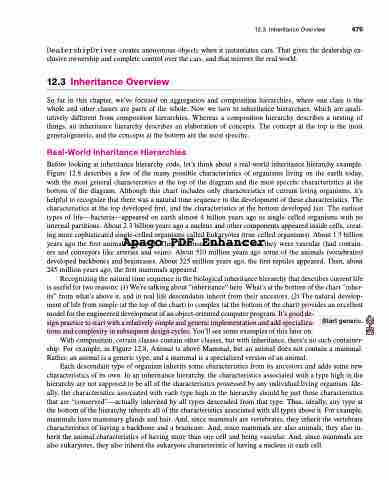Page 513 - Introduction to Programming with Java: A Problem Solving Approach
P. 513
12.3 Inheritance Overview 479 DealershipDriver creates anonymous objects when it instantiates cars. That gives the dealership ex-
clusive ownership and complete control over the cars, and that mirrors the real world.
12.3 Inheritance Overview
So far in this chapter, we’ve focused on aggregation and composition hierarchies, where one class is the whole and other classes are parts of the whole. Now we turn to inheritance hierarchies, which are quali- tatively different from composition hierarchies. Whereas a composition hierarchy describes a nesting of things, an inheritance hierarchy describes an elaboration of concepts. The concept at the top is the most general/generic, and the concepts at the bottom are the most specific.
Real-World Inheritance Hierarchies
Before looking at inheritance hierarchy code, let’s think about a real-world inheritance hierarchy example. Figure 12.8 describes a few of the many possible characteristics of organisms living on the earth today, with the most general characteristics at the top of the diagram and the most specific characteristics at the bottom of the diagram. Although this chart includes only characteristics of current living organisms, it’s helpful to recognize that there was a natural time sequence in the development of these characteristics. The characteristics at the top developed first, and the characteristics at the bottom developed last. The earliest types of life—bacteria—appeared on earth almost 4 billion years ago as single-celled organisms with no internal partitions. About 2.3 billion years ago a nucleus and other components appeared inside cells, creat- ing more sophisticated single-celled organisms called Eukaryotes (true-celled organisms). About 1.3 billion years ago the first animalAs appaeargedo. ThePy hDadFmorEe tnhanhoanencecll,eanrd they were vascular (had contain- ers and conveyors like arteries and veins). About 510 million years ago some of the animals (vertebrates) developed backbones and braincases. About 325 million years ago, the first reptiles appeared. Then, about 245 million years ago, the first mammals appeared.
Recognizing the natural time sequence in the biological inheritance hierarchy that describes current life is useful for two reasons: (1) We’re talking about “inheritance” here. What’s at the bottom of the chart “inher- its” from what’s above it, and in real life descendants inherit from their ancestors. (2) The natural develop- ment of life from simple (at the top of the chart) to complex (at the bottom of the chart) provides an excellent model for the engineered development of an object-oriented computer program. It’s good de-
sign practice to start with a relatively simple and generic implementation and add specializa-
tions and complexity in subsequent design cycles. You’ll see some examples of this later on.
With composition, certain classes contain other classes, but with inheritance, there’s no such container- ship. For example, in Figure 12.8, Animal is above Mammal, but an animal does not contain a mammal. Rather, an animal is a generic type, and a mammal is a specialized version of an animal.
Each descendant type of organism inherits some characteristics from its ancestors and adds some new characteristics of its own. In an inheritance hierarchy, the characteristics associated with a type high in the hierarchy are not supposed to be all of the characteristics possessed by any individual living organism. Ide- ally, the characteristics associated with each type high in the hierarchy should be just those characteristics that are “conserved”—actually inherited by all types descended from that type. Thus, ideally, any type at the bottom of the hierarchy inherits all of the characteristics associated with all types above it. For example, mammals have mammary glands and hair. And, since mammals are vertebrates, they inherit the vertebrate characteristics of having a backbone and a braincase. And, since mammals are also animals, they also in- herit the animal characteristics of having more than one cell and being vascular. And, since mammals are also eukaryotes, they also inherit the eukaryote characteristic of having a nucleus in each cell.
Start generic.


